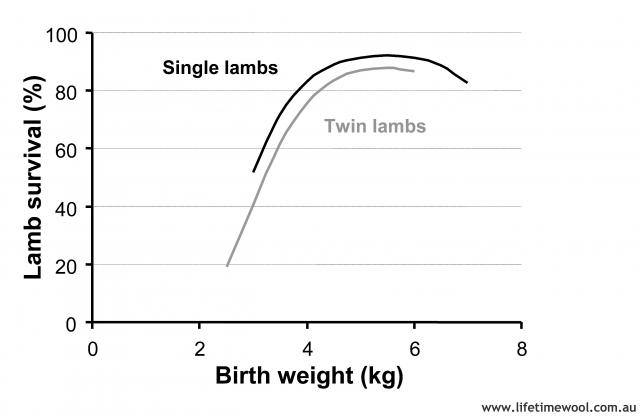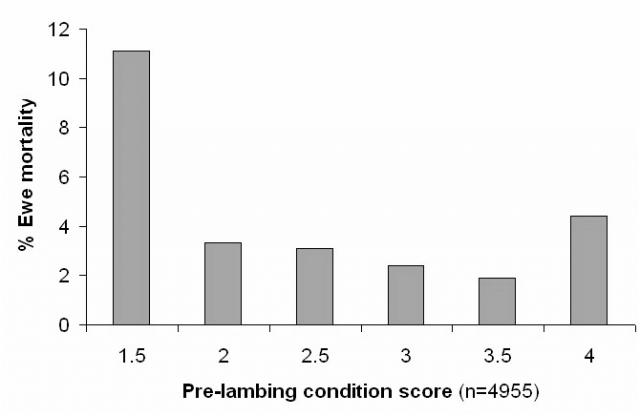The impact of nutrition in pregnancy on lamb survival
Lamb birthweight is the single most important predictor of lamb survival. Poor ewe nutrition during pregnancy will reduce lamb birth weight by up to 0.5kg if significant condition is lost. These smaller lambs – particularly twins – are less likely to survive birth and will be smaller at weaning.
The first 48 hours of a lamb's life are critical. Around 70% of lamb mortality that occurs between birth and weaning occurs within this period. Lamb survival is related to lamb birth weight. Lamb birth weight is strongly related to the nutrition of the ewe during pregnancy, particularly late pregnancy and accounts for nearly 70% of the variation in survival.
The optimum birthweight for maximum lamb survival is between 4.5-5.5kg, but lambing environment and whether they are a single or twin, also affect the response.
Ewes in better condition at lambing have heavier lambs
Ewes in better condition at lambing produce bigger lambs. Optimal birthweights are from 4-6kg and a decrease in condition score of ewes during pregnancy can reduce lamb birthweight by 0.4-0.5kg in both single and twin lambs. Birthweights are most sensitive to changes in ewe condition in late pregnancy.
The impact of lamb birthweight on lamb survival
Lamb survival rate is mostly explained by differences in lamb birthweight but the lambing environment (such as bad weather, mothering) and whether they are born as a single or twin lamb affects the response.
Survival decreases sharply when lamb birthweight drops below 4.0kg. A 0.5kg decrease in birthweight from the average has less effect on the survival of single lambs than the survival of twin lambs (approximately 10-15% lower).

Lamb birthweight is determined by ewe nutrition both in early pregnancy (during placental development) and in the last third of pregnancy, which is a period of rapid foetal growth. Ewe nutrition during late pregnancy and lambing has a large effect on lamb survival through its influence on lamb birthweight.

Single bearing ewes should be in condition score 2.8 or more, and twin bearing ewes should be at least in condition score 3 by lambing to optimise lamb survival, especially in an environment susceptible to poor lambing conditions.
Poor ewe nutrition and low condition at lambing also has detrimental effects on maternal behaviour and lamb behaviour that contribute to increased mortality. Ideally the ewe and lamb should remain at the birth site for at least six hours.
| State | Condition score at lambing | Survival of singles (%) | Survival of twins (%) |
|---|---|---|---|
| Western Australia | 2.4 | 81 | 58 |
| Western Australia | 3.5 | 92 | 82 |
| Victoria | 2.2 | 74 | 38 |
| Victoria | 3.1 | 86 | 56 |
Tips:
- Scan for pregnancy – especially litter size so twinning ewes can be separately managed.
- Ensure ewes achieve the condition score target prior to lambing – condition score 3 gives good survival and production.
- Ewes need to be condition score 3 by lambing for singles and 3.3 for twins.
- Ewes need more feed when they are pregnant especially in the last 2 months - they need to reach good condition at the time of lambing to have a good size lamb and to have energy reserves for birth.
The impact of nutrition on ewe mortality
Ewe condition score at lambing can be important in managing ewe mortality, especially when weather conditions are poor. Mortality occurs mainly when condition score is less than 2 during late pregnancy. Twin bearing ewes are more at risk during late pregnancy and lambing. Single bearing ewes may have increased risk of dystocia if they are too heavy coming into lambing.

Tips:
- Twinners should be in condition score 3.3 by lambing and on good pasture to allow unrestricted intake to limit pregnancy toxaemia.
- Single ewes should be in condition score 2.8+ by lambing and should be less than condition score 4 to limit dystocia.
- Where poor weather is likely over lambing, shelter must be provided and effective predator control is important.
- Older ewes (full mouth and older) should have higher feed on offer at lambing to ensure adequate intake.
